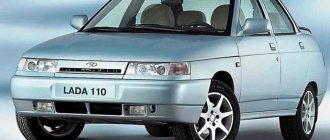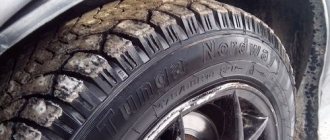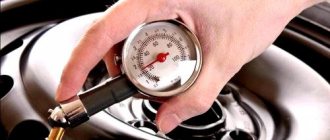GAZ cars are honored workers of our roads. They are often used to transport goods and passengers. Every owner of this brand knows how important it is to timely service the machine so that it remains in service for as long as possible. Therefore, for many car enthusiasts the relevant question is what should be the tire pressure on a cargo and passenger GAZelle.
Rubber parameters, At indicators
The size of products for such trucks depends on many reasons. A special role is played by:
- ratio of the total number of wheels and driving elements;
- the year the vehicle was manufactured;
- engine modification.
One of the veterans of the model range is the GAZ 2705 with a 4x2 wheel arrangement and a hub diameter of 13 centimeters. Size standard:
- type of tires - 185/75;
- disk size - 5.5J×16 ET106;
- the diameter of the imaginary circle (drill) is 6×170 millimeters.
For 4x4 vehicles, the typical tire size has different values. The width of such products is slightly larger, which guarantees better contact with the road surface. For model 3221 4×2, the standard parameters look like this:
- double hub radius - 13 cm;
- type of disk - similar to the option discussed above;
- tire type - 175/75 mm.
When considering what is the optimal tire pressure on a GAZelle Business or Next car, you need to remember that there are a total of 7 varieties of this vehicle. And it is Next that is the newest modification produced by the car plant since 2013. The total number of wheel elements is 4, the leading ones are 2. Basic parameters:
- type of tires - 185/75;
- disk size - 5.5J×16 ET106;
- drilling - 6 by 170 millimeters.
All these standard values are not set by chance. Only when using the appropriate tires can you eliminate the possibility of premature wear of the tires and chassis, and also make the car more obedient and controllable.
Despite this, car owners often install tires on their trucks whose typical characteristics do not correspond to those specified by the manufacturer. In such a situation, when choosing suitable products, pay attention to a number of important nuances:
- Profile width - makes it possible to calculate the size of the area of interaction between the tire and the wheel element. It is best to take options 175-215 mm.
- Diameter is the leading indicator. It is quite acceptable to set the size to 21 inches.
- Profile height - determines the value of the contact spot. Standard: 75-85 mm.
Before figuring out how many atmospheres to pump into the wheels of a GAZelle, you need to understand in detail all the subtleties and features of choosing products. If you use tires that are not suitable in size, you will not be able to eliminate the occurrence of various problems. For example:
- If the diameter or width is too large, it will inevitably interfere with the fender liners. Because of this, plastic lockers quickly fail and require replacement.
- Large parts can damage the mudguards, again leading to additional costs.
Particular attention should be paid to the profile height. If you plan to use the vehicle for cargo transportation, choose tires measuring 85 millimeters. The car will be easy to drive, which will make it possible to avoid a lot of problems on the roads.
Truck owners constantly ask themselves the question of how many atmospheres the pressure should be in the tires (wheels) of a GAZelle. After all, one of the main responsibilities of any motorist is to control the required level of At - the indicator must correspond to the norm (neither higher nor lower). Finding information on the specified characteristics recommended by the manufacturer is not difficult. To do this, look under the hood of the vehicle: in the engine area there is a small metal plate containing data on the typical tire size, their optimal diameter and the corresponding atmosphere value. If you cannot find it in the engine compartment, carefully examine the door pillar and look for it there.
Where to see the necessary indicators
Detailed information about the vehicle can be found in the technical operating manual (instructions). Usually the car owner receives it upon purchase. If you have neither the time nor the desire to look for a book, look at the tire markings. The manufacturer makes marks on the sides, indicating the required values for drive axles and tandem pairs. The numbers most often differ, so it is better to find out the recommended ones in advance.
Interesting Facts
Over the long history of GAZelle production at the Gorky Automobile Plant, many interesting events have occurred. Some of them relate to the wheels of this car:
- An all-terrain vehicle with low-pressure tires was created on the basis of the GAZelle car. The diameter of its wheels is 24 inches. The width of this tire is 1,300 mm.
- The Tetris game is built into the dashboard of the GAZelle-NEXT car.
- In 2014, the GAZ plant opened a branch in the Turkish city of Sakarya, where cargo-passenger models of these vehicles are produced.
- The NEXT model has a claimed top speed of 134 km/h, but in reality the car can reach higher speeds.
- The declared resource of the GAZelle-NEXT engine is 500,000 km, that is, it is a half-million-dollar engine.
- GAZ is developing electric vehicles based on the GAZelle, as well as unmanned vehicles.
What is the optimal pressure in the rear and front tires (wheels) on a GAZelle?
The Gorky Automobile Plant produces several modifications of cars of this type. Moreover, each model has its own characteristics, which is why their recommended AT parameters are not the same. The existing differences can be explained simply by the difference in wheel load.
So, the value for a lightweight version with sides will be approximately 2.6-2.7 atmospheres. For a heavy vehicle for passenger transportation, this figure will already be 3.0-3.5.
We also note that the volume of air in the product directly depends on the season and scope of use of the vehicle. For clarity, let’s consider two identical trucks, whose work routes run along a dirt and asphalt road. Vehicles operating on a primer require 2.6-2.8 atmospheres because they drive on an unsteady surface with poor grip. For a car traveling on asphalt, the norm will be 3.5 At, because an increase in the contact spot in such a situation is not required.
Our production
Truck tires
Tires for special equipment
Tires for agricultural machinery
Gear shift
To change gears silently, press the clutch pedal all the way down. To avoid premature wear of the synchronizers, the lever should be moved smoothly, with a short delay in the neutral position, according to the diagram shown in the figure and on the gear shift lever handle.
A fuse is provided in the gearbox to prevent accidental engagement of reverse gear R. Reverse gear is engaged only from the neutral position N. In this case, if the instruments and the starter are turned on, the reverse light comes on in the rear lights.
Requirements from the manufacturer
If you want to know how much to pump the tire pressure on a GAZelle, keep in mind that the manufacturer recommends increasing the value to 2.9-3 units (this applies to model 3302).
For other, older versions, these parameters are also relevant. However, in reality they are not the final value. The volume of air in the tires of a fully loaded car and an unoccupied minibus should be different. That is why, when selecting products for a truck, it is necessary to focus on the appropriate type of tires used and the vehicle load.
Possible problems with non-compliance with standards
When servicing your car, remember that the standards are set by the manufacturer for a reason. If there is insufficient or excessive pressure in tires, the vehicle owner will sooner or later encounter a lot of difficulties that can damage the car and entail additional costs for repairs.
If the wheels are poorly inflated:
- fuel consumption increases significantly - the vehicle needs more power, otherwise it simply will not be able to move away and start moving;
- rubber wears out much faster, since the area of its contact with the road surface increases greatly;
- the noise effect increases while driving;
- it is more difficult to control, the acceleration period becomes longer, and maneuvering becomes more difficult.
When wondering what the tire pressure on a GAZelle 3302 and other models should be according to the manufacturer’s recommendations, do not forget that excess air in tires is just as harmful as its lack:
- driving a car is uncomfortable, every hole and even a minor crack on an asphalt road is already a noticeable nuisance;
- the likelihood of a hernia occurring when falling into a pothole increases rapidly;
- the braking distance approximately doubles.
The manufacturer does not recommend that car owners exceed the permissible limit of 3.0 At. However, many motorists ignore the instructions, exceeding the indicators by up to 3.3-3.5 units. You can forget about a comfortable ride in such a situation.
Bus movement
It is recommended to start driving the bus with a partially warmed up engine. If this is not possible, and the engine is warmed up while the bus is moving, then at low ambient temperatures and after a long stay, it is recommended to move for some time in lower gears with a low engine speed. As it warms up, gradually shift to higher gears.
When overcoming a ford, make sure that its depth, taking into account the oncoming wave and the water shaft in front of the bus, does not exceed the height of the lower edge of the front buffer above the road surface; in this case, you must move at the minimum possible speed, not exceeding 20 km/h, in order to avoid water being thrown into the air intake air filter.
After overcoming a ford, after washing the bus, as well as when driving for a long time on a wet road, when water gets into the brake mechanisms of the wheels, it is necessary to perform several smooth braking while driving to dry the discs, drums and brake linings.
When driving through puddles, reduce your speed to avoid hydroplaning, which can cause skidding or loss of control; With worn tires this danger increases.
If possible, drive the bus without sudden acceleration and deceleration, as this leads to increased tire wear and increased fuel consumption.
Driving a bus in 3rd, 4th and 5th gears at low engine speeds (up to 1500 rpm) leads to additional loads on the engine and transmission and may be accompanied by the appearance of resonance phenomena in the transmission. Driving in these modes is not recommended. To avoid such phenomena, you should switch to a lower gear.
To avoid damage to the plastic housing of the clutch master cylinder, it is prohibited to operate the clutch pedal in the direction opposite to its normal movement to disengage the clutch when the bus rod is connected to the clutch pedal.
To ensure long-lasting operation of the gearbox when operating the bus, be sure to follow the following rules, which will ensure easy and silent gear shifting:
1. The clutch drive must ensure complete disengagement of the clutch. When the pedal is depressed, the clutch should not “drive”.
2. All gear changes should be carried out by smoothly moving the lever only after the clutch is completely disengaged. Shifting gears too quickly leads to premature wear of the synchronizers or their failure. It is not allowed to change gears with the clutch not completely disengaged, as well as to simultaneously operate the pedal and lever.
3. It is not allowed to engage the clutch when the gear is not disengaged.
4. Engage the rear entry gear only after the bus has come to a complete stop.
The driving axle of the bus is equipped with a bevel gear differential, which allows the bus wheels to rotate at different speeds, which is necessary to ensure stability and controllability when the bus is moving. Long-term (more than 5 minutes) slipping of one of the wheels of the drive axle can lead to overheating of the differential parts and its failure. If such a situation arises, use available means to improve wheel grip on the road or evacuate the bus from a dangerous area in tow.
Advice from experienced owners
Many drivers who drive GAZelles every day determine the optimal level of air in the wheels based on the service life of the tires and fuel consumption. Additionally, they focus on:
- road quality;
- climatic conditions;
- cargo weight, etc.
Thus, owners of versions 3302 and 2705 inflate their tires to 3.5 At - these are the numbers that are considered the norm. They guarantee the required rigidity and allow you to drive the vehicle with maximum confidence, both free and loaded. At the same time, the condition of the wheels themselves should be very good.
There are many reasons that influence the choice of the appropriate number of atmospheres. Drivers often pay attention to the quality characteristics of the products themselves. When trying to determine what pressure in the front and rear tires of the GAZelle Next Farmer and other modifications will be most acceptable, rely on the recommendations of experienced carriers. They advise inflating tires 0.5 At more than what the manufacturer writes in the data sheet.
Parking brake
To apply the parking brake to the bus, tighten the lever firmly by pulling it up. To make it easier to move the lever, simultaneously press the brake pedal. When parking on a slope, tighten the lever as necessary, it is also recommended to additionally engage the first gear of the gearbox.
On a stopped bus, if the instruments and the starter are turned on, the warning light on the instrument cluster lights up intermittently. When releasing the brake, slightly pull the lever up, press button 1 of the lock on the end of the handle and lower the lever completely down, and the warning light goes off.
Benefits of Constant Checking
To ensure that the tires do not wear out too quickly, and that the truck behaves as smoothly as possible on the road, it is necessary to systematically check the indicators. Do this at least once every two weeks. As soon as the volume of air in the wheels decreases, driving becomes much more difficult. The vehicle begins to respond more slowly to steering wheel turns, and stability at high speed decreases.
Otherwise, when the standard value is exceeded, you have to drive in extremely uncomfortable conditions. Potholes, pebbles and even small cracks in the road surface become a big problem. The service life of products, the chassis of the truck and your own nervous system can only be preserved by setting the correct At value.
To measure the volume of air, you need to use special equipment - a pressure gauge. You can find it at almost any car gas station, service station or tire shop.
To carry out the check yourself, you can purchase a pressure gauge of one of three types:
- Mechanical. It does not have high measurement accuracy and looks more like a metal writing pen.
- Switch. They are often equipped with pumps. It will help you achieve more accurate results, but you should be careful during the process. The device is extremely unstable to shocks and high-atmospheric overloads.
- Electronic. Perhaps the best option, which is simple and convenient to use.
When starting the inspection, remember that all necessary measurements are taken before the vehicle is driven out. The rubber must be cold. Check all 4 wheels.
Lockable differential
In cases where it is necessary to overcome a difficult section of the road, the differential lock allows the driver to firmly connect both rear wheels and transfer all the torque to them. The differential lock is activated by switch 1 on the instrument panel.
After pressing the switch in the instrument cluster, the rear axle differential lock indicator lights up.
When the speed reaches 30 km/h, the locking is automatically disabled and the warning light in the instrument cluster goes off. To reactivate the lock after it has automatically turned off, you must reduce the speed of the bus and press the lock switch again. The differential lock is turned off by pressing the switch again. The differential lock can be turned off while the bus is moving.
What is the tire pressure on a GAZelle thermal booth?
The standard three units of atmospheres will not be enough for such a machine. An increase in the standard indicator is required due to the impressive weight of the booth (with cargo). The structure itself weighs a lot, and when the “refrigerator” is full, you need to inflate the tires by at least 4.5 kg. Despite this, the vehicle behaves quite adequately on the road. In different seasons, additional adjustments are made according to the winter/summer principle.
Tire pressure for GAZelle (3302, Business, Farmer, etc.): table of At values
| The lineup | Options | Pressure (bar) | |||
| Empty | Downloaded | ||||
| Before | Back | Front | Rear | ||
| 2705 | 185/75 | 3,0 | 3,0 | 3,0 | 3,0 |
| 3221 | 3,0 | 2,8 | 3,0 | ||
| 3302 | 3,0 | 3,0 | 3,0 | 3,0 | |
| 33023 | 3,0 | 3,0 | 3,0 | 3,0 | |
| 2752 | 3,3 | 3,9 | 3,3 | ||
| 2217 | 215/65 | 2,7 | 2,7 | 2,8 | 2,8 |
| 22171 | 2,7 | 3,1 | 2,7 | 3,1 | |
Refueling the bus
The fuel tank is located on the left side of the bus.
To refuel the bus, open the fuel tank cap by turning it counterclockwise. To close the fuel tank cap again, place it on the neck and screw it in clockwise until it clicks into place.
To operate the engine, it is necessary to use diesel fuel in accordance with GOST R 52368–2005 (EN 590:2004) type II or III.
Depending on the ambient temperature, it is recommended to use fuel of the appropriate class or grade indicated in the table:
| Fuel class | 0 | 1 | 2 | 3 | 4 | |
| Application temperature, °C, not lower | -20 | -26 | -32 | -38 | -44 | |
| Fuel class | A | IN | WITH | D | E | F |
| Application temperature, °C, not lower | +5 | 0 | -5 | -10 | -15 | -20 |
Required parameters for model 3302
According to the standard, this is 3.0 At for the wheels front and rear. However, it happens that the meanings differ. Much depends on the modification and the normal load of the car.
If we talk about a truck with sides and an awning, the body length of which does not exceed three meters, the volume of air in the front tires can meet the standards. The rear ones are a completely different story. If the transport is not loaded, you can reduce the pressure to 2.7 atmospheres. When loading more than 1.5 tons, the standard value must be increased, bringing it to 4.0-4.5 At. Also relevant for vans and variations extended to four meters. Due to the impressive weight of the vehicle itself, you should not reduce the level below the 3 At mark (even if the car is empty).
Running in the bus
The durability of bus components and assemblies largely depends on driving style and operating conditions during this period.
While the bus is moving, even in engine braking mode on a descent, do not allow the engine to operate for a long time at a rotation speed above 3200 rpm. Do not allow an unheated engine to operate at high crankshaft speeds, either while the bus is parked or in motion.
Change to a lower gear in a timely manner, in accordance with road conditions, to avoid engine overloads associated with excessively low engine crankshaft speeds.
Suitable values for model 33023
For the cargo "Farmer", the manufacturer set the standard at 3.0 At. If the car body is loaded, it should be increased to 4.0-4.5 units. This also applies to the long version; the load capacity of both modifications is no different. In this case, you can ignore the weight of the body structure.











